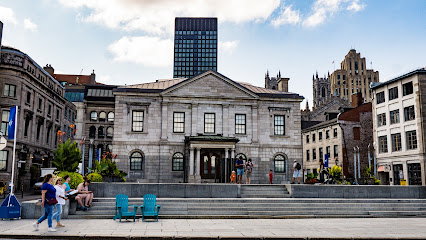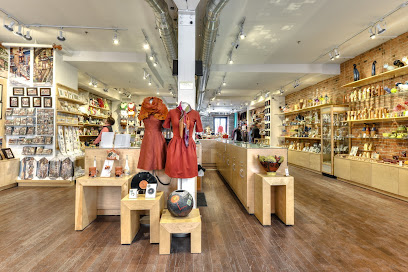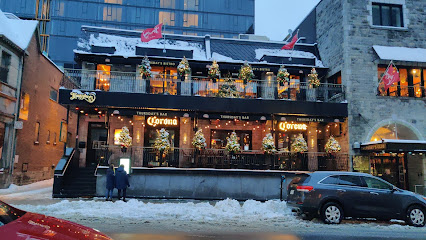
Downtown Montreal: The Heartbeat of a Vibrant City
Explore Downtown Montreal: A dynamic blend of historic charm, cultural richness, and modern vibrancy in the heart of Canada's most bilingual city.
Downtown Montreal is a bustling hub of activity that beautifully blends the old with the new. As you stroll through its streets, you'll encounter historic buildings standing tall alongside modern skyscrapers. This contrast creates a unique atmosphere that is both charming and dynamic. The neighbourhood is home to an array of attractions, including museums, art galleries, and theaters, making it a cultural epicenter. Beyond its cultural offerings, Downtown Montreal is also a shopper's paradise. Sainte-Catherine Street, the main commercial artery, is lined with a mix of high-end boutiques and popular chain stores. Food lovers will be delighted by the diverse culinary scene, which ranges from gourmet restaurants to cozy cafes and food trucks serving international cuisine. Downtown Montreal is not just about urban excitement; it also offers tranquil green spaces. Mount Royal Park, designed by the same landscape architect who created New York's Central Park, provides a peaceful retreat with stunning views of the city. Whether you're looking to explore art, indulge in shopping, or simply relax in nature, Downtown Montreal has something for everyone.
Local tips in Downtown Montreal
- Visit during summer for festivals like the Montreal Jazz Festival and Just for Laughs.
- Consider using the Underground City to navigate during winter months.
- Try local specialties like poutine and smoked meat at nearby eateries.
- Take a walk up to Mount Royal for panoramic views of the city.
- Check out the Museum of Fine Arts for an impressive collection of art.
Downtown Montreal: The Heartbeat of a Vibrant City
Downtown Montreal is a bustling hub of activity that beautifully blends the old with the new. As you stroll through its streets, you'll encounter historic buildings standing tall alongside modern skyscrapers. This contrast creates a unique atmosphere that is both charming and dynamic. The neighbourhood is home to an array of attractions, including museums, art galleries, and theaters, making it a cultural epicenter. Beyond its cultural offerings, Downtown Montreal is also a shopper's paradise. Sainte-Catherine Street, the main commercial artery, is lined with a mix of high-end boutiques and popular chain stores. Food lovers will be delighted by the diverse culinary scene, which ranges from gourmet restaurants to cozy cafes and food trucks serving international cuisine. Downtown Montreal is not just about urban excitement; it also offers tranquil green spaces. Mount Royal Park, designed by the same landscape architect who created New York's Central Park, provides a peaceful retreat with stunning views of the city. Whether you're looking to explore art, indulge in shopping, or simply relax in nature, Downtown Montreal has something for everyone.
Iconic landmarks you can’t miss
Vieux-Port de Montréal
Discover the historical charm and vibrant energy of Vieux-Port de Montréal, where culture, dining, and waterfront views come together for an unforgettable experience.

Clock Tower
Discover the enchanting Clock Tower in Montreal, a historic landmark offering stunning views of the city and a glimpse into its rich maritime heritage.

Canada Place
Discover the serene beauty of Canada Place, an urban park in Montreal offering lush landscapes, stunning architecture, and vibrant seasonal blooms.

Place de la Grande-Paix-de-Montréal
Discover the enchanting Place de la Grande-Paix-de-Montréal, a historical landmark that celebrates the rich cultural heritage of Montreal in the heart of Ville-Marie.

Le Vieux Montréal
Experience the enchanting historic charm of Le Vieux Montréal, where cobblestone streets meet vibrant culture and stunning architecture.

Monument to Paul de Chomedey, Sieur de Maisonneuve
Discover the Monument to Paul de Chomedey, Sieur de Maisonneuve in Montreal, a stunning tribute to the city's founder amidst historical architecture.

Old Montreal City
Experience the history and charm of Old Montreal City, where cobblestone streets, stunning architecture, and vibrant culture come together for an unforgettable visit.

Place Royale
Experience the rich historical tapestry of Montreal at Place Royale, a captivating landmark in Old Montreal with stunning architecture and cultural significance.

Historical Plaque - La Basilique Cathedrale Marie Reine du Monde
Explore La Basilique Cathedrale Marie Reine du Monde, Montreal's historical gem showcasing stunning architecture and rich cultural heritage.

Montreal old architecture place
Immerse yourself in the historical beauty of Montreal's old architecture, where European elegance meets vibrant Canadian culture.

Unmissable attractions to see
McCord Stewart Museum
Discover the diverse history and cultural heritage of Montreal at the McCord Stewart Museum, a captivating destination for all history enthusiasts.

Montréal en Histoires
Explore the captivating tales of Montreal's past at Montréal en Histoires, where history comes alive through innovative storytelling and stunning visuals.

Essential places to dine
Wienstein & Gavino's
Experience authentic Italian cuisine at Wienstein & Gavino's in Montreal—where every dish tells a delicious story.

Brasserie 701
Discover Brasserie 701: A premier French restaurant in Montreal offering exquisite cuisine and an elegant bar ambiance.

Kazu
Discover the vibrant flavors of Japan at Kazu in Montreal – where traditional cuisine meets modern charm.

Restaurant Jérôme Ferrer - Europea
Discover culinary artistry at Restaurant Jérôme Ferrer - Europea in Montreal, where exquisite French cuisine meets sophisticated ambiance.

Le Pois Penche
Experience authentic French dining at Le Pois Penché in Montreal - where traditional bistro flavors meet contemporary flair.

Toqué!
Experience exquisite Québécois cuisine at Toqué!, Montreal's premier fine dining restaurant known for its innovative tasting menus.

Bis Ristorante
Experience authentic Italian cuisine at Bis Ristorante in Montreal's vibrant Ville-Marie area—where every dish tells a story.

Da Vinci Restaurant / Ristorante Da Vinci
Experience the essence of Italian cuisine at Da Vinci Restaurant in Montreal, where fine dining meets culinary artistry.

La Medusa
Experience the essence of Italian fine dining at La Medusa in Montreal - where culinary excellence meets elegance.

L’Autre Saison
Experience the authentic taste of France at L’Autre Saison in Montreal – where seasonal ingredients meet exquisite culinary artistry.

Markets, malls and hidden boutiques
Souvenir du Québec
Discover authentic Quebec souvenirs at Souvenir du Québec, where local charm meets unique craftsmanship in the heart of Montreal.

Le Magasin Général du Vieux-Montréal
Experience the essence of Montreal at Le Magasin Général du Vieux-Montréal, where local craftsmanship meets unique shopping.

L'empreinte coopérative
Explore L'empreinte coopérative in Old Montreal for unique gifts, local art, and stylish accessories that capture the essence of Quebec.

Souvenirs Quebec Je T’aime
Explore the heart of Montreal at Souvenirs Quebec Je T’aime, where authentic Canadian gifts and native treasures await every traveler.

Jannat Souvenirs and sports
Explore Jannat Souvenirs and Sports in Montreal for unique gifts, local treasures, and authentic sporting goods to remember your trip.

L'Art des Artisans du Québec
Discover Montreal's rich artisan culture at L'Art des Artisans du Québec, where unique handmade gifts and crafts await.

Boutique Lotus
Discover Boutique Lotus in Montreal, where fashion, art, and home decor intertwine to offer a unique shopping experience that reflects local culture.

KURIOSITY
Discover the charm of Montreal at KURIOSITY, a vibrant gift shop filled with unique souvenirs and local crafts that capture the city's spirit.

Boutique Bonjour Montréal
Explore Boutique Bonjour Montréal for unique gifts, local treasures, and a warm atmosphere in the heart of Old Montreal.

Souvenir Cathédrale
Discover unique souvenirs and local treasures at Souvenir Cathédrale, Montreal’s charming gift shop in the heart of the city.

Essential bars & hidden hideouts
Sir Winston Churchill Pub
Discover the lively Sir Winston Churchill Pub in Montreal – a vibrant grill and sports bar offering delicious food and an inviting atmosphere.

Mad Hatter Pub
Discover the lively atmosphere of Mad Hatter Pub in Montreal, where drinks flow and memories are made in a whimsical bar setting.

Bar Le Mal Nécessaire
Experience the tropical charm and innovative cocktails at Bar Le Mal Nécessaire, a must-visit cocktail bar in the heart of Montreal's nightlife.

La Distillerie no.1
Experience the vibrant nightlife of Montreal with innovative cocktails and a lively atmosphere at La Distillerie no.1, a must-visit bar in the city.

Cloakroom Bar
Discover Cloakroom Bar in Montreal, where innovative cocktails blend with an elegant atmosphere for an unforgettable night out.

Grumpys Bar
Experience the lively atmosphere at Grumpys Bar, Montreal's go-to spot for locals and tourists seeking a vibrant nightlife scene and affordable drinks.

Pub Andrew’s
Discover the inviting atmosphere and extensive drink selection at Pub Andrew’s, a must-visit pub in the heart of Montreal.

N sur Mackay
Experience the charm and vibrant atmosphere of N sur Mackay, an intimate bar in Montreal serving expertly crafted cocktails in the heart of Ville-Marie.

Ziggy's Pub
Discover the lively spirit of Montreal at Ziggy's Pub, where great food and drinks meet a vibrant atmosphere.

London Pub
Discover the vibrant atmosphere of London Pub in Montreal, where craft beers meet delicious pub fare in a friendly setting.

Local Phrases
-
- HelloBonjour
[bon-zhoor] - GoodbyeAu revoir
[oh ruh-vwahr] - YesOui
[wee] - NoNon
[noh] - Please/You're welcomeS'il vous plaît / De rien
[seel voo pleh / duh ryen] - Thank youMerci
[mehr-see] - Excuse me/SorryExcusez-moi / Désolé
[ex-kyoo-zay mwah / day-zoh-lay] - How are you?Comment ça va?
[koh-mon sah vah] - Fine. And you?Bien. Et toi?
[byen. ay twah] - Do you speak English?Parlez-vous anglais?
[par-lay voo on-glay] - I don't understandJe ne comprends pas
[zhuh nuh kohm-prahnd pah]
- HelloBonjour
-
- I'd like to see the menu, pleaseJe voudrais voir le menu, s'il vous plaît
[zhuh voo-dray vwar luh muh-nyoo, seel voo pleh] - I don't eat meatJe ne mange pas de viande
[zhuh nuh mahnj pah duh vyand] - Cheers!Santé!
[sahn-tay] - I would like to pay, pleaseJe voudrais payer, s'il vous plaît
[zhuh voo-dray pay-yay, seel voo pleh]
- I'd like to see the menu, pleaseJe voudrais voir le menu, s'il vous plaît
-
- Help!À l'aide!
[ah led] - Go away!Allez-vous en!
[ah-lay vooz ahn] - Call the Police!Appelez la police!
[ah-play lah po-lees] - Call a doctor!Appelez un médecin!
[ah-play ahn mayd-sahn] - I'm lostJe suis perdu(e)
[zhuh swee pair-doo] - I'm illJe suis malade
[zhuh swee mah-lahd]
- Help!À l'aide!
-
- I'd like to buy...Je voudrais acheter...
[zhuh voo-dray zah-shey...] - I'm just lookingJe regarde juste
[zhuh ruh-gard zhoost] - How much is it?Combien ça coûte?
[kohm-byen sah koot] - That's too expensiveC'est trop cher
[say troh shay] - Can you lower the price?Pouvez-vous baisser le prix?
[poo-vez voo bay-say luh pree]
- I'd like to buy...Je voudrais acheter...
-
- What time is it?Quelle heure est-il?
[kel er ay teel] - It's one o'clockIl est une heure
[eel ay tun er] - Half past (10)Dix heures et demie
[dees er ay duh-mee] - MorningMatin
[mah-tan] - AfternoonAprès-midi
[ah-pray mee-dee] - EveningSoir
[swah] - YesterdayHier
[ee-air] - TodayAujourd'hui
[oh-zhoor-dwee] - TomorrowDemain
[duh-man] - 1Un
[uhn] - 2Deux
[duh] - 3Trois
[twa] - 4Quatre
[ka-truh] - 5Cinq
[sank] - 6Six
[sees] - 7Sept
[set] - 8Huit
[weet] - 9Neuf
[nuff] - 10Dix
[dees]
- What time is it?Quelle heure est-il?
-
- Where's a/the...?Où est le/la...?
[oo ay luh/lah] - What's the address?Quelle est l'adresse?
[kel ay la-dress] - Can you show me (on the map)?Pouvez-vous me montrer (sur la carte)?
[poo-vez voo muh mohn-tray (soor lah kart)] - When's the next (bus)?Quand est le prochain (bus)?
[kahnd ay luh proh-shen (bus)] - A ticket (to ....)Un billet (pour ....)
[uhn bee-yay (poor)]
- Where's a/the...?Où est le/la...?
History of Downtown Montreal
-
Downtown Montreal's history begins with the founding of the city in 1642 by Paul Chomedey de Maisonneuve and a group of settlers. Initially named Ville-Marie, it served as a French mission and trading post. The strategic location along the St. Lawrence River facilitated trade and interaction with Indigenous peoples, laying the foundation for what would become a bustling urban center.
-
The 19th century marked a period of rapid industrialization in Downtown Montreal. The opening of the Lachine Canal in 1825 allowed for the efficient transport of goods, leading to the establishment of factories and warehouses. The area became a hub for commerce, with the construction of significant buildings such as the Bonsecours Market in 1847, which served as a focal point for trade and community gatherings.
-
Throughout the late 19th and early 20th centuries, Downtown Montreal became a melting pot of cultures, largely due to waves of immigration from Europe. Communities from Ireland, Italy, and Eastern Europe established themselves in the area, contributing to the city’s diverse cultural landscape. This period saw the construction of iconic structures like the Notre-Dame Basilica, completed in 1829, which showcases Gothic Revival architecture and serves as a testament to the city’s rich religious heritage.
-
The mid-20th century brought significant changes to Downtown Montreal’s skyline, with the construction of skyscrapers like the Place Ville-Marie in 1962. This iconic building, designed by architect I.M. Pei, symbolized the city’s growth and modernization. The development of the Underground City in the 1960s further transformed the area, creating an extensive network of shopping centers, metro stations, and office buildings, catering to the needs of a growing urban population.
-
Downtown Montreal has evolved into a cultural epicenter, home to numerous institutions like the Montreal Museum of Fine Arts, established in 1860, and the Place des Arts, which opened in 1963. These venues play a vital role in showcasing local and international art, music, and theater, reinforcing Montreal's reputation as a UNESCO City of Design. The area also hosts various festivals, including the Montreal International Jazz Festival, which attracts millions of visitors annually.
Downtown Montreal Essentials
-
Downtown Montreal is easily accessible from various neighborhoods in the city. The Metro system, operated by the Société de transport de Montréal (STM), is the most efficient way to reach Downtown. The Green Line (Line 1) and Orange Line (Line 2) both have stations in the area, including Peel, McGill, and Bonaventure stations. If you prefer buses, numerous routes connect Downtown to other neighborhoods. For those coming from the airport, the 747 Express Bus provides direct service to Downtown, running every 30 minutes.
-
Downtown Montreal is pedestrian-friendly, with many attractions within walking distance. The STM Metro system is a reliable option for longer distances, while buses are readily available. Biking is popular, with BIXI bike-sharing stations throughout the area. Taxis and rideshare services like Uber are also convenient for getting around, especially at night. Consider purchasing a transit pass for unlimited travel on public transport, which can be a cost-effective choice for tourists.
-
Downtown Montreal is generally safe for tourists, but it is advisable to remain vigilant. Avoid poorly lit areas at night, particularly around certain parts of the Quartier des Spectacles and near the Berri-UQAM station, which can have higher crime rates. Keep personal belongings secure and be cautious of pickpockets in crowded places. Always trust your instincts and seek assistance from local authorities if needed.
-
In case of an emergency, dial 911 for police, fire, or medical assistance. The main hospitals in the Downtown area include the McGill University Health Centre (MUHC) and the Jewish General Hospital. It is advisable to have travel insurance that includes medical coverage. For minor health issues, pharmacies are widely available throughout Downtown, many of which are open late.
-
Fashion: Do dress in layers, as Montreal weather can change quickly. Casual, stylish clothing is widely accepted. Don’t wear excessively revealing clothing in religious sites. Religion: Do respect local customs, especially in churches. Don’t take photographs in places where it is prohibited. Public Transport: Do be courteous and give up your seat for those in need. Don’t eat or drink on the Metro. Greetings: Do greet with a friendly 'Bonjour' or 'Salut.' Don’t use overly informal language until you know someone better. Eating & Drinking: Do try local specialties like poutine and bagels. Don’t waste food, as it is considered impolite.
-
To experience Downtown Montreal like a local, explore the hidden gems in the neighborhood, such as the vibrant street art in the Plateau Mont-Royal area and the quaint cafes in the Old Port. Visit the Atwater Market for fresh produce and local delicacies. Attend local events and festivals, especially during the summer, to immerse yourself in the culture. Don’t miss the chance to try a smoked meat sandwich at Schwartz's, a Montreal institution. Lastly, take a stroll along the Lachine Canal for a scenic view of the city.
Trending Landmarks in Downtown Montreal
Nearby Cities to Downtown Montreal
-
Things To Do in Burlington
-
Things To Do in Stowe
-
Things To Do in Lake Placid
-
Things To Do in Montpelier
-
Things To Do in Halifax
-
Things To Do in Ottawa
-
Things To Do in Middlebury
-
Things To Do in Killington
-
Things To Do in Rutland
-
Things To Do in Hanover
-
Things To Do in Woodstock
-
Things To Do in Quebec City
-
Things To Do in Saratoga Springs
-
Things To Do in Laconia
-
Things To Do in Bennington













